OUR OLD FACTORY BY THE SEA
(From Historical Footnotes, August 2003)
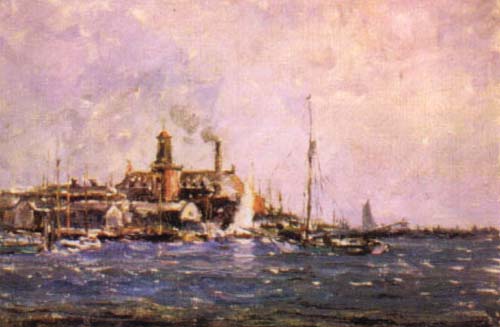
There sits the Atwood Machine Company, captured in a tiny oil by Reynolds Beal (1866-1951), the impressionist who painted the Connecticut shore from his yawl a century ago. The year is 1898. Although the painting is fancifully titled "Ata-Du-Sills Mill, Stonington" (a garbling of "Atwood silk mill?"), the 1851 John F. Trumbull building and its tower are unmistakable, as are the wooden sheds that Atwood replaced with a brick building twenty years later. Now, after standing for a century and a half as a reminder to the Borough of the hard working side of life, it has disappeared while a grandson of the Clifford Mallory who was Beal's close friend, was involved in transforming it into homes. It may eventually be replicated, but what is left of the original is a shell and rubble seen (below) on July 4, the day after it was devastated by fire. (Painting from the Florence Griswold Museum: Gift of the Hartford Steam Boiler and Inspection Company)

In the beginning, it was the Joslyn Fire Arms Company ...
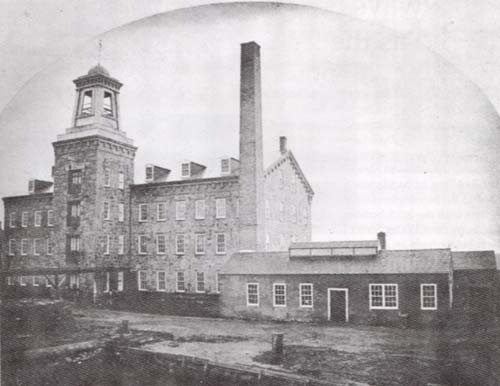
In 1851, John F. Trumbull set his granite factory building on Stonington harbor, not far from the little fort that opposed the British fleet when it paid a hostile call in 1814. The building (shown, from the north side, in the photo above in the 1860s) was leased first to a maker of horseshoe nails, then to a fabricator of trinkets for the South Seas trade. But its most notable early tenant was the Joslyn Fire Arms Comnpany, named for Benjamin F. Joslyn, of Worcester, and incorporated locally. During the Civil War, it manufactured 16,500 breechloading carbines, most of which were used by Union cavalry. It closed soon after the war and, entangled in a local financial scandal, had its assets sold at a sheriff's sale in 1868. Carbine parts and ammunition were found in the building as much as sixty years later. After Joslyn's collapse, the building had a series of short term tenants until the arrival in 1876 of the Atwood Machine Company. The old building was gutted in the fire of July 3, 2003, but most of the outer walls remained standing (as seen below, from the south).
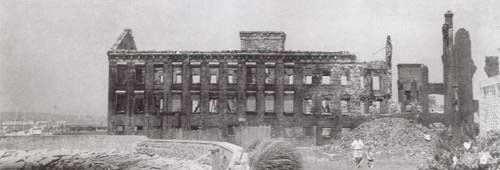
... and it was later Plax and Monsanto, but it will always be remembered as the ...
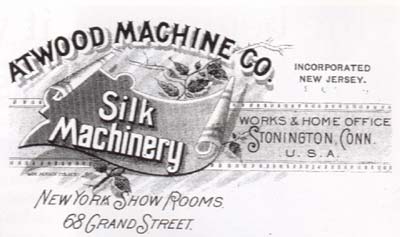
The Atwood Machine Company was founded by mechanical geniuses, John E. Atwood and his son Eugene, who invented advanced machinery for making silk thread. A fire drove them from their plant in Willimantic, Connecticut, in 1876. They moved to the Trumbull factory building in Stonington and remained there for seventy years. The company prospered, setting up offices in New York (see 1895 letterhead, above) and selling its handsome machines around the world. It added to the Stonington factory, first with long wood buildings, then with the brick building, put up during World War I, that hung over Water Street for nearly ninety years. (See air view below from an Atwood advertising brochure.) The company began to decline after the death of Eugene Atwood in 1926, when the its traditional innovativeness failed to keep pace with new challenges in the textile industry, such as the rise of knitted and woven goods and the appearance of rayon and nylon. It rallied strongly from the devastation of the 1938 hurricane (see photograph from the company newsletter below). Atwood almost closed before World War II, but won an Army-Navy "E" for its work on war contracts and put off the inevitable until 1945, when it was sold. Subsequent tenants included Emhart Manufacturing, the Plax Corporation, and the Monsanto Company, which operated there until 1982, then left, and the factory stood empty for twenty years, waiting for rescue or disaster.
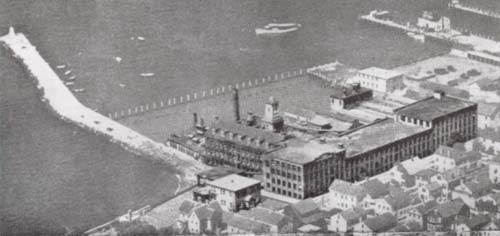
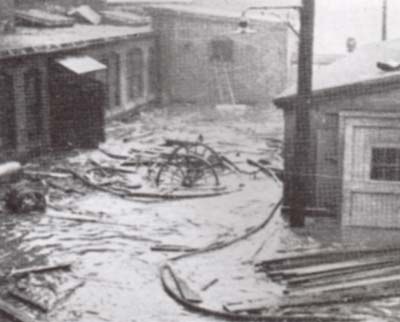
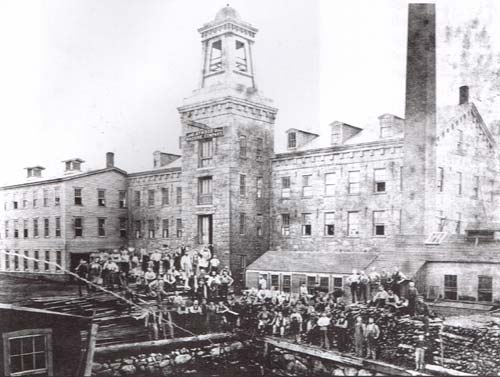
Hundreds of Stonington men and women passed through the old factory. One generation of Atwood workers posed for the photograph above, perhaps a hundred years ago, before the wooden sheds on the left were removed to make way for the new brick building. Below is what remained of the scene on July 4, 2003. Another photo shows the Atwood sign on the northeast corner of the brick building; the picture below it shows the remnant standing (for a few days) after the fire. The promise of what was to become of the old factory is shown in the Stonington Commons sign hanging outside the developers' office on Water Street. It may happen yet, but the new factory as condominiums is destined to be a replica, not the original.
